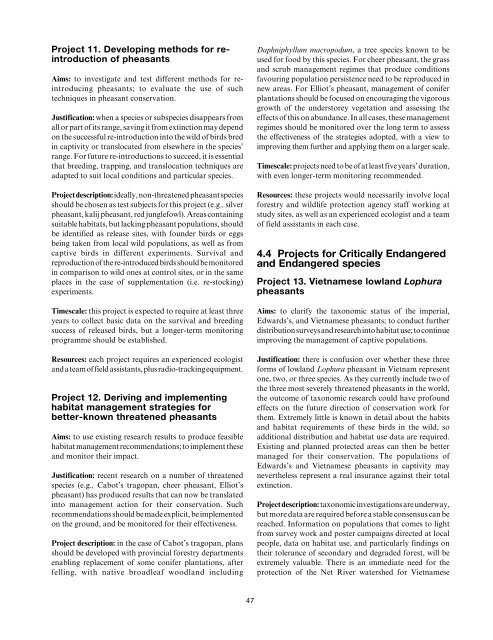Pheasants: Status Survey and Conservation Action Plan ... - IUCN
Pheasants: Status Survey and Conservation Action Plan ... - IUCN
Pheasants: Status Survey and Conservation Action Plan ... - IUCN
Create successful ePaper yourself
Turn your PDF publications into a flip-book with our unique Google optimized e-Paper software.
Project 11. Developing methods for reintroduction<br />
of pheasants<br />
Aims: to investigate <strong>and</strong> test different methods for reintroducing<br />
pheasants; to evaluate the use of such<br />
techniques in pheasant conservation.<br />
Justification: when a species or subspecies disappears from<br />
all or part of its range, saving it from extinction may depend<br />
on the successful re-introduction into the wild of birds bred<br />
in captivity or translocated from elsewhere in the species’<br />
range. For future re-introductions to succeed, it is essential<br />
that breeding, trapping, <strong>and</strong> translocation techniques are<br />
adapted to suit local conditions <strong>and</strong> particular species.<br />
Project description: ideally, non-threatened pheasant species<br />
should be chosen as test subjects for this project (e.g., silver<br />
pheasant, kalij pheasant, red junglefowl). Areas containing<br />
suitable habitats, but lacking pheasant populations, should<br />
be identified as release sites, with founder birds or eggs<br />
being taken from local wild populations, as well as from<br />
captive birds in different experiments. Survival <strong>and</strong><br />
reproduction of the re-introduced birds should be monitored<br />
in comparison to wild ones at control sites, or in the same<br />
places in the case of supplementation (i.e. re-stocking)<br />
experiments.<br />
Timescale: this project is expected to require at least three<br />
years to collect basic data on the survival <strong>and</strong> breeding<br />
success of released birds, but a longer-term monitoring<br />
programme should be established.<br />
Resources: each project requires an experienced ecologist<br />
<strong>and</strong> a team of field assistants, plus radio-tracking equipment.<br />
Project 12. Deriving <strong>and</strong> implementing<br />
habitat management strategies for<br />
better-known threatened pheasants<br />
Aims: to use existing research results to produce feasible<br />
habitat management recommendations; to implement these<br />
<strong>and</strong> monitor their impact.<br />
Justification: recent research on a number of threatened<br />
species (e.g., Cabot’s tragopan, cheer pheasant, Elliot’s<br />
pheasant) has produced results that can now be translated<br />
into management action for their conservation. Such<br />
recommendations should be made explicit, be implemented<br />
on the ground, <strong>and</strong> be monitored for their effectiveness.<br />
Project description: in the case of Cabot’s tragopan, plans<br />
should be developed with provincial forestry departments<br />
enabling replacement of some conifer plantations, after<br />
felling, with native broadleaf woodl<strong>and</strong> including<br />
Daphniphyllum macropodum, a tree species known to be<br />
used for food by this species. For cheer pheasant, the grass<br />
<strong>and</strong> scrub management regimes that produce conditions<br />
favouring population persistence need to be reproduced in<br />
new areas. For Elliot’s pheasant, management of conifer<br />
plantations should be focused on encouraging the vigorous<br />
growth of the understorey vegetation <strong>and</strong> assessing the<br />
effects of this on abundance. In all cases, these management<br />
regimes should be monitored over the long term to assess<br />
the effectiveness of the strategies adopted, with a view to<br />
improving them further <strong>and</strong> applying them on a larger scale.<br />
Timescale: projects need to be of at least five years’ duration,<br />
with even longer-term monitoring recommended.<br />
Resources: these projects would necessarily involve local<br />
forestry <strong>and</strong> wildlife protection agency staff working at<br />
study sites, as well as an experienced ecologist <strong>and</strong> a team<br />
of field assistants in each case.<br />
4.4 Projects for Critically Endangered<br />
<strong>and</strong> Endangered species<br />
Project 13. Vietnamese lowl<strong>and</strong> Lophura<br />
pheasants<br />
Aims: to clarify the taxonomic status of the imperial,<br />
Edwards’s, <strong>and</strong> Vietnamese pheasants; to conduct further<br />
distribution surveys <strong>and</strong> research into habitat use; to continue<br />
improving the management of captive populations.<br />
Justification: there is confusion over whether these three<br />
forms of lowl<strong>and</strong> Lophura pheasant in Vietnam represent<br />
one, two, or three species. As they currently include two of<br />
the three most severely threatened pheasants in the world,<br />
the outcome of taxonomic research could have profound<br />
effects on the future direction of conservation work for<br />
them. Extremely little is known in detail about the habits<br />
<strong>and</strong> habitat requirements of these birds in the wild, so<br />
additional distribution <strong>and</strong> habitat use data are required.<br />
Existing <strong>and</strong> planned protected areas can then be better<br />
managed for their conservation. The populations of<br />
Edwards’s <strong>and</strong> Vietnamese pheasants in captivity may<br />
nevertheless represent a real insurance against their total<br />
extinction.<br />
Project description: taxonomic investigations are underway,<br />
but more data are required before a stable consensus can be<br />
reached. Information on populations that comes to light<br />
from survey work <strong>and</strong> poster campaigns directed at local<br />
people, data on habitat use, <strong>and</strong> particularly findings on<br />
their tolerance of secondary <strong>and</strong> degraded forest, will be<br />
extremely valuable. There is an immediate need for the<br />
protection of the Net River watershed for Vietnamese<br />
47
















